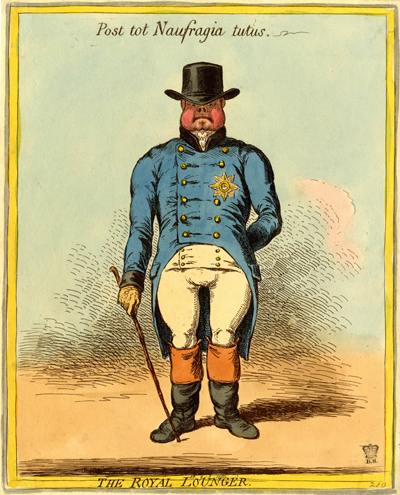The Royal Lounger
Like most portrait caricatures in the Italian tradition, the The Royal Lounger portrays its subject at full length against a blank background. And like the Darly macaroni prints, the sitter is not specifically named, but identified by allusion.

© Trustees of the British Museum
In this case, the title suggests that the subject is a member of the royal family who may be distinguishing himself not so much by his activities, but by his inactivity. And the Latin tag above his head (which can be translated as "After so many shipwrecks, [now] safe.") associates him with a seafaring life.
And so we arrive at the identification of the subject as Prince William, the Duke of Clarence, who had been designed since he was a boy for the Royal Navy, and who had appeared in a number of other Gillray prints, such as Wouski (1788) Nauticus (1791), and Lubber's Hole (1791) in naval uniform. But he had effectively retired from active service in the Navy after 1790 and his positions since then had been purely honorary.
Unlike most portrait caricatures, which usually present their subjects in profile, this is one of only a handful of portraits, including The Leadenhall Volunteer (1797), Field Marshall Count Suwarrow-Romniskoy (1799), and The Military Caricaturist (1799) where Gillray presents his subject face forward. And it is the only one which combines that unusual perspective with another age-old caricature technique—the portrayal of the subject as an animal. In this case, a pig.
The Duke as pig may have been prompted by the discussion in Parliament going on at this time about the ballooning size of the civil list where an unexpected line item of £16,000 payable in installments to the Duke of Clarence was discovered by a Mr. Bankes in his review of expenses.
If the salary of that illustrious personage, or any other branch of the Royal Family, were found inadequate to provide for the comforts which belonged to the station they occupied, he would be as ready as any man to consent to any increase that might be necessary; but he disliked the principle of such occasional advances as that to which he alluded. . . . It would serve to place the Princes of the blood in a kind of dependence upon the First Lord of the Treasury, who might, if this practice were tolerated, advance any sum he pleased in this clandestine manner. . . .
As reported in The Courier, July 3rd, 1804.
As the son of a soldier, Gillray had always been sensitive about the pathetic pay given to men in the military who actually defended their country. (See Six-Pence a Day (1775) and A New Way to Pay the National Debt (1786). So it is not surprising to find him caricaturing the Duke for his non-service during wartime. Indeed, he had already and specifically expressed his resentment of freeloaders in his bitterly ironic A True British Tar (1795), which also featured the Duke of Clarence.
Sources and Reading
- Commentary from the British Museum on The Royal Lounger
- "William IV of the United Kingdom," Wikipedia
- Thomas Wright and R.H. Evans, Historical and Descriptive Account of the Caricatures of James Gillray #479
Comments & Corrections
NOTE: Comments and/or corrections are always appreciated. To make that easier, I have included a form below that you can use. I promise never to share any of the info provided without your express permission.